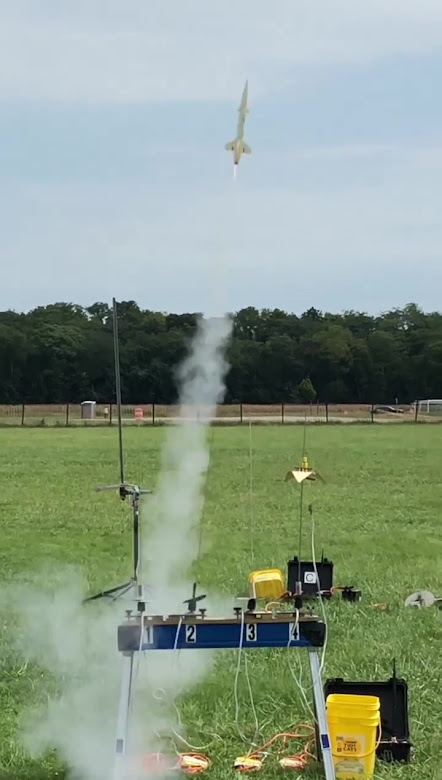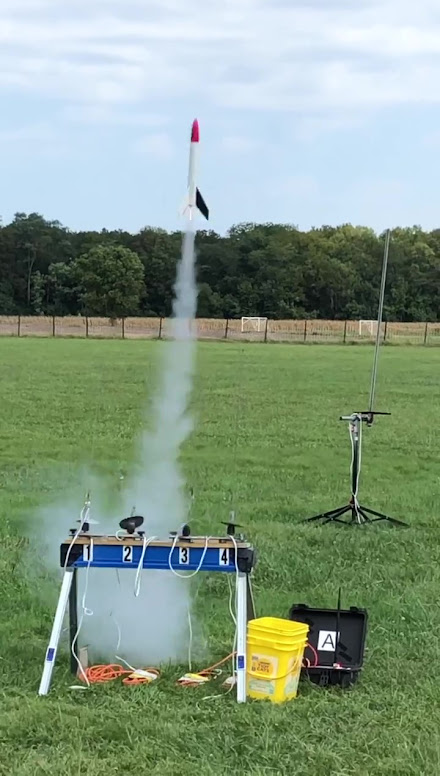Because of social obligations, I didn't get to do my normal Friday night prep session, so I headed for the WSR launch in Dayton with 20+ rockets, few of which had received any pre-launch attention. I was running late as usual, having stopped for both breakfast and motors on the way. There was a decent crowd when I arrived, with a dozen or so flights already in the air and a surprisingly strong breeze out of the southwest. Our wind speed indicator showed a steady 6 to 8 knot breeze, with occasional gusts above 10. The forecast was for increasing windspeed to 15 knots. Brisk.
It had been almost a month since our last launch, and I had finished several projects in that time that I was anxious to put in the air, along with my continuing quest to fly my backlog of kits that had been gathering dust, in some cases as far back as 2001. First off the pad on this breezy Saturday would be a new build, the Estes Expedition.
I don't know if I got this from an Estes clearance or from Hobby Lobby. Whatever the case, I should have bought a couple more. Even slathered with Fill & Finish it performed far better than expected. Winds were pretty stout all day, to the point that we were picking spots between gusts to launch. That was the story with the Expedition. It windcocked heavily to the right on the E12-6 and flew deep into the field toward the Rip Rap Roadhouse.
As you can see, I left my mad skillz with the camera at home. Either that or the wind blew my aim off. The flight topped out around 800' and the ejection charge fired when the rocket was horizontal and it immediately began racing back toward the flightline. It passed us moving at a good clip and impacted hard, then bounced five feet in the air. I anticipated the worst, but found all fins present and accounted for. Can't say I'm looking forward to the sanding to come, but I really like this bird.
Second flight of the day would be a seldom flown eBay purchase, an Estes Bullpup 12D that hadn't seen the skies since 2013. Not sure of the timeline on this kit, but I'd guess it was fairly old considering that it had water slide decals.
The flight would be a C6-5 and would follow that of the Expedition, windcocking heavily to the right as it left the pad and recovering while almost horizontal. It topped out around 600' and quickly crossed back to the left and deep into the football field. I noted that I could have lessened the recovery walk if I'd cut a spill hole in the parachute, but I didn't build the rocket.
My third flight would be another long neglected bird, an upscale of the FSI Sprint. The previous flight had been in 2013 and had resulted in a 1.5" zipper, and I hadn't gotten around to giving the body tube a haircut until recently.
Since the Expedition flight didn't overfly the field, this would be another E12-6 flight. The large fins made this one flail around on the pad pre-flight, but somehow the clips kept their grip on the igniters.
I angled the pad into the breeze more on this one than I did the Expedition and got a very similar flight path to 800'. The extra tilt showed up more in recovery, and the Sprint recovered a lot closer to the flightline than the Expedition, by a couple hundred yards actually. It also looked good coming down under the 12' nylon chute, which likely helped with the close recovery.
Flight #4 would be another eBay rocket, an Estes ARCAS that had been saddled with a horrible custom set of fins when I received it. I flew it as it looked when it showed up, but deep down I really wanted to give it a do-over.
A couple of weeks back I was walking past the ARCAS in the basement hall and picked it up to see how well the fins were attached. The answer was not all that well, and I had the offending set of fins off in a couple of minutes. New fins were cut and fitted into place, then the body was resprayed gloss white and a decal printed off. The end result is a lot more satisfying than the previous off the rails custom, and I don't think it will be another six years before it flies again.
Sticking with the scale theme, the next flight would be the Quest Harpoon. Okay, pseudo-scale. It would be a C6-5 flight as would everything else I flew from this point.
This was another that hadn't flown in years, six to be exact. This would be the second flight, the first one coming at B6-4 Field on the requisite B6-4. The breezes had become more insistent at this point, and the Harpoon was angled slightly into the wind. As everything else had on the day, the flight windcocked right and climbed to 600'. It was an oddity on the day in that recovery came to the right of the pads, and as I was recovering it I joined in a search for a missing case that was thought to have been ejected from a flight that lawn darted. It was later found in the airframe of the crushed rocket.
No idea what happened next. The "flight" would be an Estes Super Alpha on a C6-5, but despite a perfect ignition the Super Alpha didn't moved from the pad.
That said, the next actual flight would be the same Super Alpha on another C6-5. I flew this rocket a lot in the year after it was introduced, but the last flight prior to this was at B6-4 Field on a B6-4, a great combination.
Nothing about the plastic nose cone or the generic looking decal did much for me, so I bought a Semroc cone and painted it like the Alpha that I got for my birthday in 1978. Built that one on Friday, painted it on Saturday, and flew it into some woods at the back of the NKU campus on Sunday.
The flight was exactly like the the Harpoon before it, windcocking to the left and topping out around 600', but in this case, recovering far to our left on the football field.
My last flight on the day, although I didn't realize it at the time, would be the Estes Big Bertha that I'd bought unopened via eBay and painted in the 1977 paint scheme on the face card.
At this point you know how the flight turned out; windocked to the left in the ever stiffening breeze, then a rapid recovery back across the field to the left on the football field. The wind was definitely becoming a decision maker for me, and I was about to find out just how much.
Though I didn't realize it at the time, my day was done. I still had 10+ rockets prepped in the car, but nothing that I wanted to risk in the stiff breezes. I realized this when I took what would be flight #9 to the pads. It was a clone of the Coaster Space Probe 1 that I'd last flown in 2017. While I was about to take the on-pad glamour shot, a particularly violent gust spun the rocket, causing a fin to whack a part of the pad. Something about it didn't sound right, kind of like the sound a bat makes when it cracks. Sure enough, the impact had broken one of the fins down near the bottom by the glue fillet. I'm not a smart man, but I know when to put the lid on the box of chocolates and climb on the shrimp boat. And the good news was that I already had ten rockets ready to go.



























As always, great flight report! Nice set of models.
ReplyDeleteI feel emboldened to try my pack of E12s. You’ve had pretty good luck with them recently.
ReplyDeleteI like the Bertha’s yellow color. Kind of a “lemon” yellow.
You know how it is, flying E motors is like snake charming. Things will be going along fine and then you get bitten. These days I've been bitten as much by C11s and D12s as I have by Es. Even the A10s aren't as friendly as they used to be. My motors are stored in an interior room where the temps never drop below 68 or get above 74, so I'm confident that the issue isn't on my end. Still, I do seem to have a tendency toward snakebite.
ReplyDelete